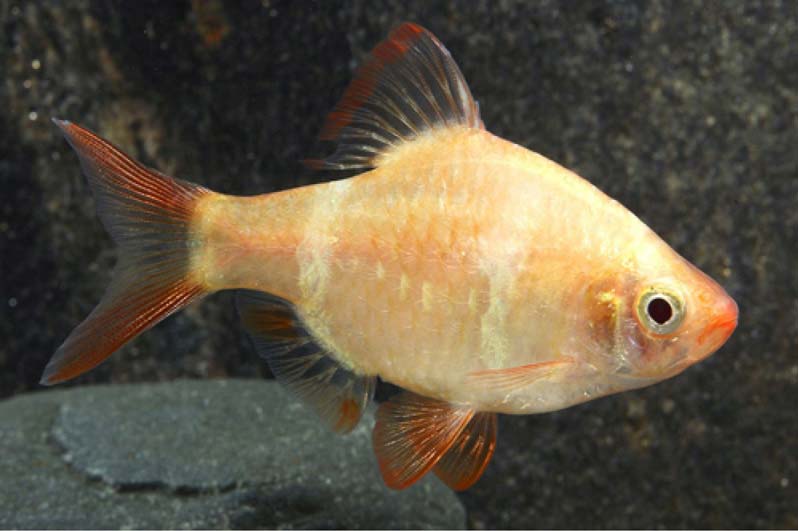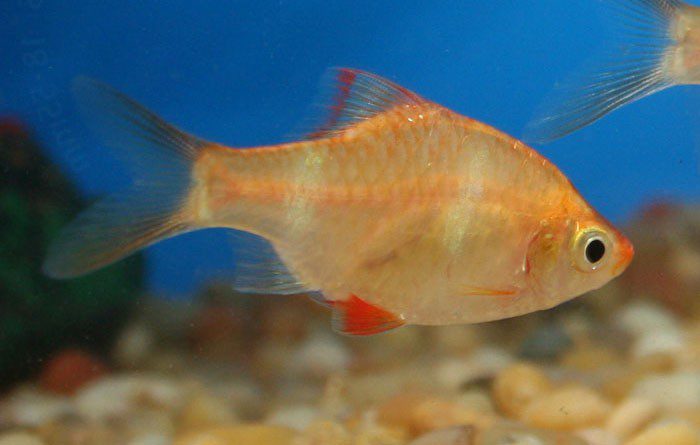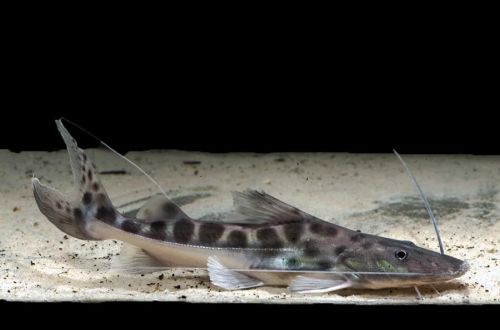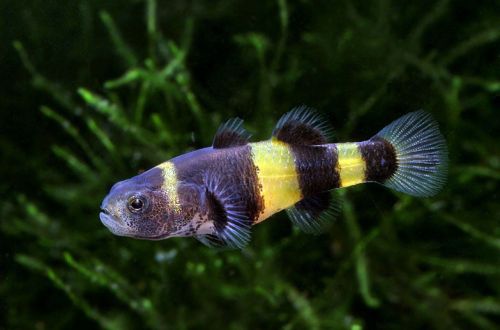
Platinum barbus
The Sumatran barb (albino), scientific name Systomus tetrazona, belongs to the Cyprinidae family. This subspecies is the result of selection of the Sumatran Barbus, which received a new body color. It can range from yellow to creamy with colorless streaks. Another difference from its predecessor, in addition to color, is that albino does not always have gill covers. Other common names are Golden Tiger Barb, Platinum Barb.

In most cases, during the selection process, fish become demanding on the conditions of detention, as happens with any artificially bred animals. In the case of the Albino Barbus, this situation was avoided; it is no less hardy than the Sumatran Barbus and can be recommended, including to beginner aquarists.
Requirements and conditions:
- The volume of the aquarium – from 60 liters.
- Temperature – 20-26°C
- Value pH — 6.0–8.0
- Water hardness – soft to medium hard (5-19 dH)
- Substrate type – sandy
- Lighting – moderate
- Brackish water – no
- Water movement – moderate
- Size – up to 7 cm.
- Meals – any
- Life expectancy – 6-7 years
Contents
Habitat
The Sumatran barb was first described in 1855 by explorer Peter Bleeker. In nature, fish are found in Southeast Asia, the islands of Sumatra and Borneo; in the 20th century, wild populations were brought to Singapore, Australia, the USA and Colombia. Barbus prefers transparent forest streams rich in oxygen. The substrate usually consists of sand and rocks with dense vegetation. In the natural environment, the fish feeds on insects, diatoms, multicellular algae, and small invertebrates. The albino barbus does not occur in nature, it is bred artificially.
Description

The albino barb has a flat, rounded body with a high dorsal fin and a pointed head. Often fish have no or almost no gill cover – a by-product of selection. The dimensions are modest, about 7 cm. With proper care, life expectancy is 6–7 years.
The color of the fish varies from yellow to creamy, there are subspecies with a silver tint. White stripes are noticeable on the body – a legacy from the Sumatran Barbus, they are black in him. The tips of the fins are reddish, during the spawning period the head is also painted red.
Food
Barbus belongs to omnivorous species, with pleasure uses dry industrial, frozen and all types of live food, as well as algae. The optimal diet is a variety of flakes with the occasional addition of live food, such as bloodworms or brine shrimp. The fish does not know the sense of proportion, it will eat as much as you give it, so keep a reasonable dose. Feed should be 2-3 times a day, each serving should be eaten within 3 minutes, this will avoid overeating.
Maintenance and care
The fish is not demanding on the conditions of keeping, the only important requirement is clean water, for this it is necessary to install a productive filter and replace 20–25% of the water with fresh water every two weeks. The filter solves two problems at once: it removes suspended matter and harmful chemicals and creates water movement, this allows the fish to be in good shape and show their color more brightly.
Barbus prefers to swim in open areas, so you should leave free space in the middle of the aquarium, and plant plants densely around the edges in a sandy substrate where you can hide. Pieces of driftwood or roots will be a great addition to the decoration, and will also serve as a basis for algae growth.
It is desirable that the length of the tank exceeds 30 cm, otherwise for such an active fish a small enclosed space will cause discomfort. The presence of a lid on the aquarium will prevent accidental jumping out.
Social behavior
Small agile schooling fish, suitable for most aquarium fish. An important condition is keeping at least 6 individuals in a group, if the flock is smaller, then problems may begin for sluggish fish or species with long fins – barbs will pursue and sometimes pinch off pieces of fins. In a large flock, all their activity goes to each other and does not cause inconvenience to other inhabitants of the aquarium. When kept alone, the fish becomes aggressive.
Sexual differences
The female looks overweight, especially during the spawning season. Males are distinguished by their bright coloration and smaller size; during spawning, their heads turn red.
Breeding / breeding
The albino barb becomes sexually mature at a body length of more than 3 cm. The signal for mating and spawning is a change in the hydrochemical composition of water, it should be soft (dH up to 10) slightly acidic (pH about 6.5) at a temperature of 24 – 26 ° C. Similar conditions are recommended to be created in an additional tank, where the male and female then sit down. After the courtship ritual, the female lays about 300 eggs, and the male fertilizes them, later the couple is transplanted back into the aquarium, as they are prone to eating their eggs. Feeding fry requires a special type of food – microfeed, but you should be careful, not eaten leftovers quickly pollute the water.
Diseases
Under favorable conditions, health problems do not arise, if the water quality is not satisfactory, the Barbus becomes vulnerable to external infections, primarily ichthyophthyroidism. More information about diseases can be found in the section “Diseases of aquarium fish”.
Features
- Flock keeping at least 6 individuals
- Becomes aggressive when kept alone
- There is a risk of overeating
- Can damage the long fins of other fish
- Can jump out of the aquarium





